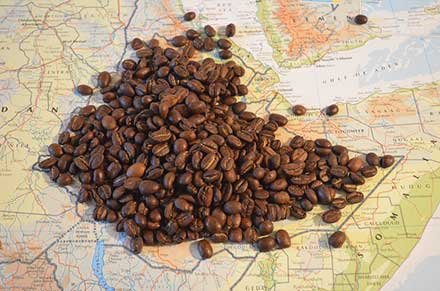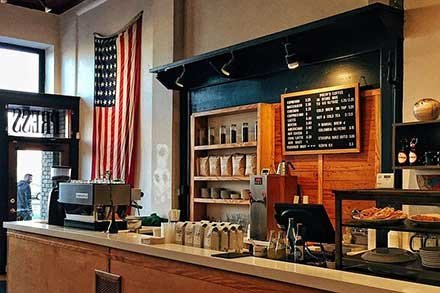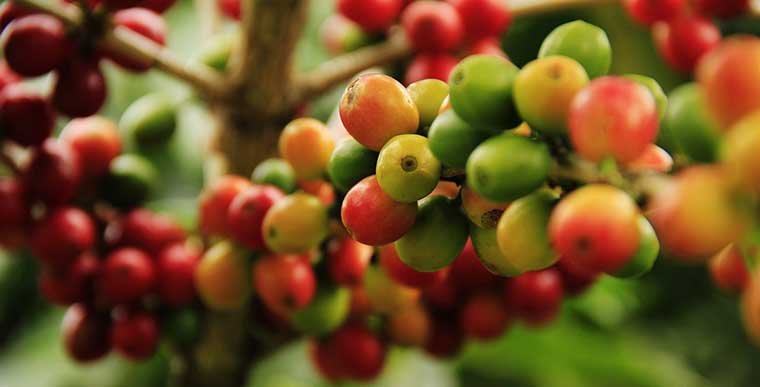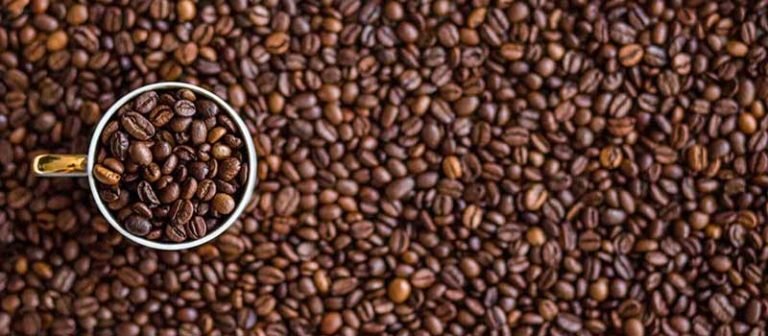The best way to start your day might be with a hot cup of joe! It has become such a staple part of our morning routines that we often take it for granted. Curious as to how this beloved beverage first became so ingrained into society? We often hear people asking, “where does coffee come from?” First, you need to understand that there are two main types of coffee beans: Arabica and Robusta beans.
Arabica beans come from higher altitudes because they need more rain due to their thin skin, but these high altitudes also lead to cooler temperatures, making for sweeter tasting coffees. On the other hand, Robusta coffee comes from lower altitude areas because it can better withstand dryer climates with its thicker skin and less sugar content than Arabica beans due to warmer weather conditions. Now that you know about the two types of coffee, keep reading, and we will tell you all about their history, as well as some interesting facts about what makes coffee special!
The Best Coffee Machines that You Can Buy Online.
Extensively Reviewed by a Coffee-Enthusiastic.

Where does Coffee come from? Coffee’s Origin

Coffee is the second most traded commodity on earth, and its popularity continues to grow worldwide. But where does coffee come from? And how did it become so popular? Coffee comes from coffee beans. It is a brewed drink made from roasted coffee beans that are ground, usually caffeinated, and boiled in water for a few minutes. It has been grown worldwide since ancient times, but today the majority of world production takes place in Brazil, Colombia, Indonesia and Vietnam.
The first recorded instance of humans drinking coffee was in Yemen around 800 AD, when they began using it as an alternative to wine during Islamic observances. In 1583 Turkish people introduced coffee into Cairo, which ultimately led to its introduction into Europe. Muslim scholars banned coffee in the 16th century, but coffee houses began to pop up throughout Europe during the next few centuries and in 1657, the first cafe opened in Venice. By 1700 the French were drinking as much as 40 gallons of coffee per person per year, making them one of the biggest consumers at that time.
So how was the coffee made? Who invented the coffee brewing machine? The first coffee roasting device was invented in 1500 by an Arabian man named Al-Shukri! By 1570 a Dutch inventor, Conrad Van Houten, had designed the first paper filter. Meanwhile, in 1818 James Burchill created the vacuum brewing machine to brew coffee without splattering it all over himself while working at a Scottish brewery! In 1840 French chemist Amedee Peres discovered that caffeine occurred naturally in coffee beans, leading to more pure and flavorful cups of Joe.
It wasn't until the 1850s that Angelo Moriondo figured out how to extract enough flavour from roasted beans into espresso. He built a steam-powered piston machine that left rough ground coffee soaking in water for about 24 hours. It was then pushed through a filter which pulled solubles out of the liquid and into the coffee grounds while leaving behind oils and other non-soluble substances.
In 1901 Giuseppe Cipresso designed a machine that could pump water directly through finely-ground coffee to make espresso. Finally, in 1905 Luigi Bezzera built upon Moriondo's design and figured out how to produce handheld shots of concentrated caffeine by adding steam pressure from a boiler. Despite much skepticism regarding the safety of this new drink, it became wildly popular because of its small size, cheaper cost, and more intense flavour!
Where was Coffee invented? Is Ethiopia the birthplace of coffee?

We know that coffee originated in Africa probably sometime during the 15th century. But where was coffee invented? Well, no one knows for sure, but there are a few theories! The first theory is that coffee was discovered by shepherds living in what is now Ethiopia. One of the herders known as Kaldi, noticed their animals became livelier after eating the berries of certain trees, and they soon began to drink the resulting liquid because it made them feel great too! This was very beneficial to farmers who could use the extra help when taking care of their livestock.
As their popularity grew, other people started to sit up and pay attention. They began to drink the coffee and take it home. Soon news of this beautiful new drink had spread all over Africa! However, the fact is we simply don't know for sure where coffee originally came from because there are no written records about its birth, so people can only make guesses based on what they know. For this reason, some people think that maybe Ethiopia isn't where coffee was born but rather one of the other countries mentioned before! Either way, we can be sure that it came from Africa because there have never been any traces that suggest otherwise.
What is clear, though, is that as news spread about coffee's wonderful effects, it quickly became a favourite drink in many parts of the world. But even today, hundreds of years after its discovery, we still don't know exactly how it makes us feel so energetic and alert or why an added boost is always welcome!
Other than Ethiopia, did you know that the majority of African countries do not grow coffee? Although Africa is home to many different climates, only about 20% produce coffee beans. The top 10 African producers are Burundi, Kenya, Ethiopia, Rwanda and Tanzania in East Africa. Malawi on southern shores near South Africa's border coast with Mozambique; Nigeria across western borders from Ghana. Uganda north eastwards towards Sudan for a short stretch before cutting back south into Congo-Kinshasa. As well as parts of eastern DRC - formerly Zaire; Angola inside west-central latitudes bordering Namibia and Zambia plus some small areas around Zimbabwe.
Fast-growing African nations like Kenya, Ethiopia, and Uganda (which brought out the first commercially grown Arabica beans in Africa) are already moving into the coffee market niche. Although there is plenty of sun, many countries receive rain or hail throughout the year, which affects crops' quality. In addition, the Arabica bean is not native to Africa or any other continent for that matter, except maybe Australia, where European settlers brought it!
Arabica coffee originated in Ethiopia and is thought to be a natural hybrid between a small-leaved wild plant and another unknown species of coffee. Many think that the plant might have been brought to Ethiopia by birds. These plants were later transported out of Ethiopia and into Yemen, where they became fully domesticated. It is recorded that Suleiman Pasha, an Egyptian governor in Turkey, tried to grow coffee there but failed because he did not know how to treat his plants properly.
He got better advice from a Jewish physician who told him to allow his seeds to float down the Nile River during its annual flooding rather than trying to take them directly from the area around Lake Tana in Ethiopia! The first Arabicas were grown outside of Arabia, which soon died due to inadequate care and disease problems with local pests such as rats.
Apart from Ethiopia, other African countries that grow coffee have primarily switched to the production of Robusta, which matures more quickly and is, therefore, better for instant coffees. With this in mind, mass producers like Nestlé have expanded their influence into Uganda, where there are large amounts of land with good soil. The company has linked up with local farmers and smaller companies to source beans from plantations on the slopes of Mount Elgon at over 3200 feet above sea level (1000 m). They cultivate Arabica trees that produce higher quality beans than those grown at lower levels. They also run a seed bank to help maintain this variety.
Where does Coffee grow? Continents & Countries which Grow Coffee
This drink that we now all know and love started from humble beginnings: at first, it was made by chewing the seeds and then spitting them out! So, where does coffee grow? Although it originated in Ethiopia, today, most of the coffee produced is from Brazil and Vietnam. Coffee derived from a perennial plant, and the seeds of "berries" are produced in clusters. A coffee tree will produce for around 25 years.
Around two-thirds of all coffee made worldwide comes from just four countries: Brazil, Vietnam, Colombia and Indonesia. The biggest importers include Germany and France. Research in Ethiopia has shown that coffee can improve memory, as well as reducing the onset of Parkinson's and Alzheimer's disease. The most expensive coffee is not necessarily the best. Below are some of the countries and continents that produce coffee!
Africa

Coffee has been grown on African soil for centuries, and many of us enjoy that brew every day with our morning cup o' joe to get us going so we can start our days off right! But did you know that the variety of coffee beans in Africa, called coffee Arabica's roots, are native to Ethiopia? It was grown only for domestic use for many decades, but nowadays, many farmers have decided to develop it as an export crop.
Of course, in some countries in Africa, like Madagascar, coffee is not grown because people don't drink it very often. But, there are also a couple of exciting things about African coffee production that you should know. For example, according to the Coffee Research Institute of Colombia, African nations take up about 14% of world output, and Arabica beans dominate over Robusta! And even though this seems like a pretty small percentage – that doesn't mean that African nations aren't the top producers of coffee.
Kenya alone produces more than 1 billion kilograms of coffee per year! In addition, the Democratic Republic of Congo is not too far behind, with a little more than half a billion kilograms per year! That is still an impressive 250 million kilograms. So then, if Africa produces so much coffee and exports it all over the world, you would think that Africans drink a lot of coffee themselves, but this is not true!
Central America
Central America is home to a variety of green coffee beans, including the Arabica and Caturra, Catuai, and Maragua cultivars. The French introduced coffee in Haiti, but it wasn't until 1727 that the Spanish arrived in Costa Rica and began cultivating it. In total, there are 11 Central American countries where Arabica is grown, Nicaragua being one of them, which produces about 8% or so of total production for export. Coffee trees in Costa Rica thrive as long as they are kept at an altitude over 2000 ft above sea level – any lower than that, and you will start noticing some funny things happening with your plants like defoliation or dying off completely!
But apparently, this is a pretty mild problem compared to the pests and moulds that affect coffee trees which causes farmers so much grief. You might be surprised to find out that over 40 species of fungi attack coffee plants! However, scientists have discovered that "solutions do exist" by creating fungicide sprays or some other kind of defence mechanism like pheromones to attract parasitic wasps. These methods have allowed countries like Costa Rica and others to produce high-quality Arabica without having their crops decimated by fungus every year.
However, these lab-grown coffees are astronomically expensive. In 2015, Costa Rican man Ezequiel Miralles paid $60 for a single cup of lab-grown coffee. However, it remains to be seen if consumers will pay that much for a cup of coffee. Coffee in Central America has historically been significantly cheaper than coffee imported from the United States, leading many to believe that lab-grown coffee will never enter mainstream markets. The price of natural Arabica may have to rise for consumers to adopt a synthetic product into their lives. It is still to be seen how this will affect coffee prices globally.
Spain

Spain is said to be known for having one of the healthiest diets in the world. In total, Spain produces about 1.2 million bags of coffee every year – now that is a lot! People have had the most success when growing coffee beans, especially in Andalusia and Valencia, where orange trees are abundant. It is here where you'll find the highest quality Arabica varieties like Value d'Or or LA7 grown, known for their smooth flavour.
Spain also grows native Robusta variety plants with higher caffeine content but makes for a more bitter brew if made into espresso! But remember, though, that Robusta coffee isn't as popular because of several factors and issues such as its taste and production - its seeds are pretty bitter and yields are usually low, so it is used more for blends. Coffee in Spain is mainly consumed in espresso, and though they are known for their Churros, Spanish Lavender Latte is also great.
United states of America

Coffee is a standard drink in the US. It is grown worldwide and has been consumed for centuries, with different cultures having their favourite varieties. Coffee was first introduced to North America by European explorers who brought coffee beans back from Africa as early as the 1720s. These days there are over 20 million people that enjoy drinking this beverage every day! We have more than 600 chemical compounds found within roasted coffee bean studies.
Studies show caffeine helps improve mood, focus or concentration while reducing fatigue and enhancing physical performance. Coffee became popular in the United States when a merchant named John Carter landed on our shores. He brought coffee beans and began to sell them, kickstarting American demand for this delicious drink from afar. One of his former business partners, James Folger Jr., would start one of America's most iconic brands: Folgers Coffee Company! From its humble beginnings as a small family-owned company selling roasted whole bean coffees direct mail order. He sold these precious cargoes to eager Americans who were learning to appreciate this exotic beverage.
This kickstarted the demand for coffee here, but it would still take a few decades before most Americans became hooked on this fantastic drink. James Folger Jr, decided to roast them himself and sell them in packages at the grocery store! During this time, he also brought in other talented entrepreneurs who built upon his vision to create the best coffee company. They started their company by selling roasted whole bean coffees via direct mail order. A revolutionary idea back then because people had never dreamed of being able to buy things over mail! Slowly but surely, the story of Folger would come to reshape the way Americans prepared coffee.
They started with just one type of roasted whole bean coffees, but that changed over time as they began introducing new flavours and varieties in their coffees. Their first offering was a medium roast coffee which was called Mark Twain. It had a sweetness that was enhanced by a touch of caramel flavour. The last to be added to the pack included something special. a 100% Colombian Supremo coffee, which offered a rich flavour! It was this one that would eventually become their signature offering.
Folgers always strives to create the best-tasting coffees for all its customers, so they never stop at just four kinds of roasted whole beans. They also offer flavoured varieties like Cinnamon Sticks, Vanilla Lattes and others. If you want to add an extra kick to these flavours, you can also find cappuccino blends at your local grocery store or cafe. These are pre-ground, so you can enjoy them right after opening the package. However, if you prefer something more traditional, then Folger's will allow home roasters to purchase their ground coffees as well.
Middle East

The Middle East has grown coffee beans for now, and Yemen has been a large exporter of coffee beans for years! It is even where the name 'Arabica' originated from. The best Arabica beans are grown at altitudes ranging between 2000 ft to 3000 ft. However, the Middle East is more famous for its Robusta plants that thrive better where there is a lot of sun and create larger yields, especially when compared to its counterpart.
Only one country in the MENA regions produces high-quality Arabica coffee: Israel. Other than that, it is mostly used as blends rather than as single-origin espressos because of factors such as the defects like over-fermentation or moulds that develop if growing areas aren't kept at just the right temperature levels. The most popular roasts of coffee from the Middle East are Vienna/City Roast (lightest) to Italian and Full City Roast (darkest).
Espresso roasts are also quite popular as well, and these fall between Italian roast to Full City Roast. In the Middle East, coffee is exported along the Red Sea to African countries like Yemen, Djibouti and Ethiopia, while overland, it is exported via truck to Persia, Turkey and Iran.
Asia and the Pacific Islands
Coffee is grown in many parts of Asia, including places like India, Vietnam, Indonesia, Taiwan, the Philippines and Sri Lanka. Where did coffee originate in Asia? So, where do coffee Arabica grow? On the tropical island of Java (Indonesia), coffee was discovered around 1500 A.D., which later spread to other islands in this region.
Besides the traditional Indonesian coffee, Vietnam and South Korea are also two countries that produce a large amount of Asian coffee production – so we should take note that they aren't all just your typical Arabica beans! Even though most Asian nations don't have as much land area as African nations do for growing coffee, it still plays an important role in their economy. In India, coffee production contributes about 1% of the total revenue.
With a certain percentage of Arabica beans being produced there, they can export their produce to European nations because it is more of an aromatic coffee bean. This type of bean gives you high levels of caffeine which can sometimes have a lower acidity level. So, if you are wondering where your morning cup of coffee comes from and want to try something with more kick than what your local Starbucks barista makes for you – keep this in mind: Indian coffees might just be what'll give you that jolt!
Pacific Islands like Indonesia use Robusta beans because they take on some unique flavour properties during the roasting process, unlike Arabica beans. They are the best candidates for high-altitude growing areas because of their resistance to pests and diseases. The higher the altitude you grow coffee at, the more acidic it becomes – so this is a great trait for Robusta beans to have! Besides all of these different types of lattes, there are still specific Asian varieties. One in particular called Kopi Luwak from Indonesia has gained a lot of popularity recently as an expensive type of coffee that can be purchased at specialty stores worldwide.
How do Coffee Beans Grow in South America?

In South America, Colombia normally grows Arabica beans, while Brazil comes along with Robusta! Since coffee's first introduction, it has been important throughout Latin American history due to its role in cultures such as a beverage and a commodity export. Many Latin American countries have made it their main export in today's world, especially Brazil, which produces a large amount of African coffee.
The International Coffee Organization (ICO) reports that South America produces around 37% of coffee worldwide! So, how do coffee beans grow in South America? Since Arabica and Robusta coffee are two common types of coffee beans that most people know the characteristics of, let us talk a little bit about some rarer varieties of coffees. Specialty coffees are defined as "high quality” coffee that is more costly than normal retail coffee.
These coffees can be referred to by their geographic location or the place they are grown. It is important to note that specialty coffee does not mean high-quality coffee – it refers only to its higher price. Both grow common varieties such as Cerrado in Brazil and Medellin in Colombia, but there are some rarer varieties we need to know about!
Those from Brazil include:
- Acai - From the Amazon rainforest. It is a fruit you have probably heard about, and it has caffeine content!
- Carajas/Caraguatá – This type of coffee is very rare in Brazil, produced in an isolated area called Caraguatá on the border of Rio state. Thanks to its rich soil and rainfall, it is grown at higher altitudes than the other coffees previously mentioned and produces some of the highest quality beans.
- Carmo de Minas is a washed variety that is most often processed by women using their traditional "Rancho" method. Most are certified organic as well because they are not exposed to enough chemicals during processing. They are usually yellowish-brown in color.
Those from Colombia include:
- Geisha – These beans grow on certain species of trees like the "Geisha schimperiana" and are used to make Arabica specialty coffee. You will see it as a single origin or as part of an exotic blend.
- Bourbon – This coffee is often confused with Typica, but the two are different! It is mainly grown at medium altitude and does very well at a lower amount of rainfall. When wet-processed, it produces honey-colored beans, unlike other varieties that yield light brown or green beans.
- Typica – Originally found in Yemen, this variety has been prized for over 200 years since its introduction to Latin America! It is commonly planted in places like Haiti, Jamaica, and the Dominican Republic, but Colombia produces it.
Here are some types of coffee you might find as a single-specialty origin or part of an exotic blend:
- Geisha – This type of coffee gets its name from the small town where it was discovered in Ethiopia by Kaldi. The beans have thin skin, which makes them difficult to harvest. They are very aromatic with heavy fruit notes and lower acidity levels than other varieties when they are processed correctly.
- Catimor - This type has soft green colored beans that produce a light, sweet taste with a medium body and low acidity. When roasted, it is a bit oily and slightly floral with some grapefruit undertones.
- Dragon's Blood – This variety comes from the red fruit found on a certain tree in Africa; the beans are almost purple! It produces a medium to full body profile with high acidity and thus one needs to drink with consideration as it can lead to cancer due to its acidity levels.
- Typica - As mentioned before, this type of coffee is pretty well-known due to its excellent taste and large production globally! It grows best at an altitude between 1,300 meters and 2,100 meters high in places like Mexico, Guatemala or Honduras, where there's enough rainfall for plants to survive through the dry season.
Coffee bean Origin (Arabica & Robusta)
Arabica is the most popular coffee plant. This type of bean produces a more mild flavor, and it can be grown at higher altitudes because its leaves are denser than other beans, making for better shade coverage over crops. Coffee bean origin for both Arabica and Robusta is said to be Ethiopia! Arabica comes from Ethiopia in East Africa, where colonialists first discovered this species after observing that many people there liked to drink cups of black liquid before eating their meals (this was how they brewed it back then).
The word "coffee" derives from an Arabic phrase meaning: wine or whiskey made with water boiled down until nearly dry. This drink was named as coffee because such drinks were customarily served during Muslim prayers on Friday as well! On the other hand Robusta is a variety of coffee beans that originated in Africa. It was created by cross-breeding robust coffees from Central America and East African Arabicas with the dark varieties native to Ethiopia, Rwanda, Kenya and other parts of Eastern Africa.
Robusta has been more popular than its counterparts, Arabica, because it costs less money while still providing consumers with a strong caffeine fix for their morning cup o' joe! Robusta beans are hardier and grow at lower altitudes. They produce a harsher tasting coffee. Therefore, you should not drink too much as they are known to cause cancer.
Back in the day, people who were too poor to afford anything else used Robusta, which was often burned into granules and ground by hand (that's how they made it as recently as your parents' or grandparents' generation). Robusta also contains more caffeine, so it can be grown in places that Arabica cannot survive, like parts of Africa, India and Southeast Asia.
Do Coffee beans grow on trees?

We have heard a lot of people ask the question, "Do coffee beans grow on trees?" “ and “coffee where do you grow?” But we have never seen anyone actually provide a definitive answer to the question. It is possible that coffee beans grow on trees if you count coffee cherries as trees or if they are grown in a forest setting, where there are many types of trees around. As for whether beans come from coffee tree trunks? Most probably not.
A coffee plant has leaves much like other plants but it doesn't have any branches. It is bush-like with medium sized leaves and tends to be about four feet high. The term "coffee tree" is misleading, as coffee beans do not grow on trees. The plants that produce the berries from which they are harvested come in a variety of shapes and sizes with different growing habits depending on their type. Robusta bushes or shrubs for example can grow up to 6 meters tall while arabica need more shade and tend to stay under 3 m (10 ft) high.
The Best Coffee Machines that You Can Buy Online.
Extensively Reviewed by a Coffee-Enthusiastic.

Conclusion
If you are one of those who has always asked, where does coffee come from? We hope this article has helped you understand a little more about how coffee is grown and produced. Therefore, next time you enjoy a cup of joe, you will have an appreciation for all the hard work put in it before it gets to your table!
As a coffee enthusiastic Dave share with you his latest and greatest coffee news and insights. He es always interested in trying out new things about the best bean of the world!
More Posts in this Category:


